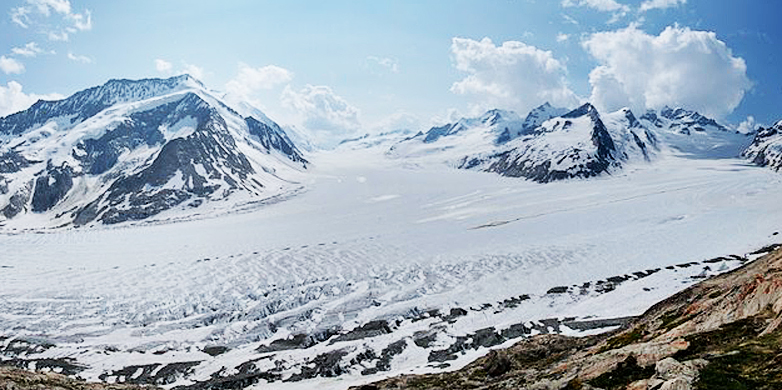Glacier simulation sheds light on accident after 88 years
In March 1926, four young men failed to return from their ski tour on Aletschgletscher. Working on the basis of where their remains were found, a mathematician and a glaciologist are now attempting to reconstruct what happened.
At midday on a March day in 1926, four men, three of whom were brothers, met at Hollandiahütte above Aletschgletscher. According to eyewitness accounts, they set off in the afternoon to Konkordiaplatz where three smaller glaciers converge to compose the Aletschgletscher. This was the last time that anybody saw them alive.
Lost in the ice for 86 years
The remains of the three brothers were found 86 years later by two British mountaineers. Working on the basis of where the bones were found, mathematician Guillaume Jouvet from the research group of Professor Ralf Kornhuber at Freie Universität Berlin and Glaciology professor Martin Funk from ETH Zurich have used a computer model to retrace the location at which the men must have lost their lives and been absorbed by the glacier. The reconstruction suggests that they froze to death. There is still no trace of the fourth man.
While completing his doctoral thesis at the EPF Lausanne in 2010, Jouvet worked together with ETH professor Funk and other glaciologists to develop a computational model that for the first time allowed to reproduce the three-dimensional flow characteristics of the glacier. The model also provides details on the speed of the glacier and its growth and shrinkage over time. Using this state-of-the-art model, they initially reconstructed the past of Aletschgletscher and simulated its future development in a changing environment. The researchers have now used the model to retrace the path taken by the remains of the brothers as they were carried along by the ice mass. This allowed them to localise the area in which the mountaineers must have disappeared, and to demarcate an area of 1,600 by 300 metres.
Brothers were disoriented as they froze to death
The site identified is in the area of the Grosser Aletschfirn, in the valley north of the Hollandiahütte, leading the researchers to conclude that the men had become disoriented. During the afternoon of 4 March 1926, a snow storm set in that lasted three days. According to the researchers, it can thus be assumed that the men froze to death. Heavy snowfall that covered the missing brothers might be the reason why they were not found despite an intensive week-long search. According to measurements, the snow that fell after 4 March had not melted by the time the following winter set in.
Buried below more than 250 metres of ice
The ice-flow model used by the researchers calculated that the bodies must have been transported in the ice over a total distance of about 10.5 kilometres at an average speed of 122 metres a year. The reconstructed line of movement reveals that they were buried some 250 metres below the surface of the glacier in 1980. At around 20 bar, the pressure exerted on the bodies was 20 times greater than atmospheric pressure, as indicated by the deformed bones, the researchers write. The bodies finally reached Concordia sometime after 1980. Their line of movement then moved to the right and, as the speed diagram illustrates, the speed at which they were transported by the glacier increased to up to 200 metres a year.
Had the bodies been found at the time they were released by the glacier, they would have been discovered in a mummified state, as was the case with the discovery of Ötzi in 1991. A forensic examination of the bones was unable to provide precise details on how long the bodies had already been at the surface before being found. In addition to other areas of uncertainty, this is another possible source of error that has to be taken into account when reconstructing the location of where the mountaineers lost their lives. Funk emphasises that this is one reason why an area and not a specific point has been identified in which it is thought that the bodies were immersed in the ice.
The researchers were able to minimise further uncertainties in the modelling by varying the underlying parameters. “The different simulations also confirmed the accuracy of our model published in 2011,” says Jouvet. Only the parameters applied in the researchers’ model would have been able to retrace a reasonable and realistic course of movement.
Solving other cases with simulations
This unconventional method of testing the simulation of the glacier's movement came about somewhat by chance. With the discovery of the bones, Funk saw an opportunity to validate the model presented in 2011. It was clear that if the model was accurate, it would also be possible to reconstruct the area in which the brothers disappeared into the glacier. Funk and Jouvet hold out the possibility that they may be able to help in solving other cases; for example, the Dakota C-53 US military aircraft that crash-landed on the Gauligletscher in the Bernese Alps on 19 November 1946 and which subsequently disappeared. With the help of the simulation, the researchers may be able to forecast when the military aircraft will be released from the glacier.
Further reading
Jouvet G and Funk M: Modelling the trajectory of the corpses of mountaineers who disappeared in 1926 on Aletschgletscher, Journal of Glaciology, Vol 60, Issue 220, 2014 doi: external page10.3189/2014JoG13J156call_made
Jouvet G, Huss M, Blatter H and Funk M: Modelling the retreat of Grosser Aletschgletscher in a changing climate, Journal of Glaciology, external page57(206), 2011call_made.

